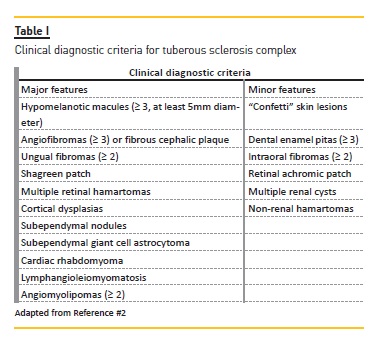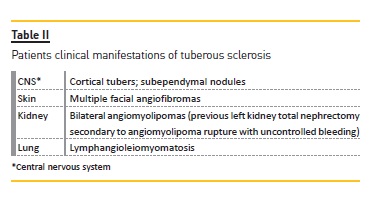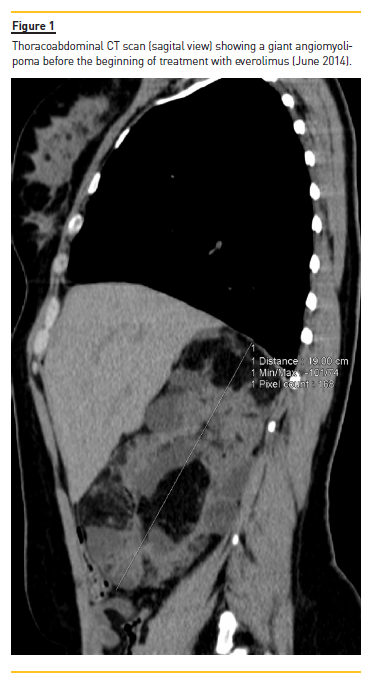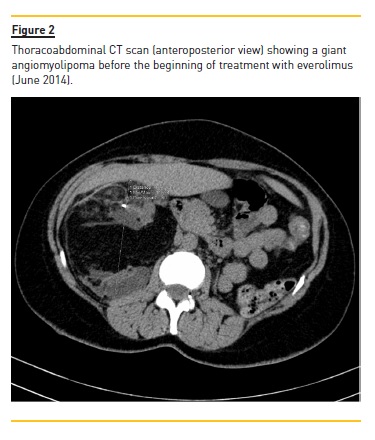Serviços Personalizados
Journal
Artigo
Indicadores
-
 Citado por SciELO
Citado por SciELO -
 Acessos
Acessos
Links relacionados
-
 Similares em
SciELO
Similares em
SciELO
Compartilhar
Portuguese Journal of Nephrology & Hypertension
versão impressa ISSN 0872-0169
Port J Nephrol Hypert vol.30 no.2 Lisboa jun. 2016
CASE REPORT
Everolimus in the treatment of giant renal angiomyolipoma associated with tuberous sclerosis
Miguel Oliveira1, Marta Sofia Costa1, Tiago Barra1, Andreia Silva1, Tânia Sousa1, Joana Rodrigues2, Filipa Costa2, Sérgio Lemos1
1 Nephrology and Dialysis Unit, Centro Hospitalar Tondela-Viseu, Portugal
2 Department of Imagiology, Centro Hospitalar Tondela-Viseu, Portugal.
ABSTRACT
Tuberous sclerosis complex is an autosomal dominant disorder characterized by the development of multiple tumours in distinct organs, although the ones most frequently affected are the skin, central nervous system, kidney, lung and liver. The kidney is the third most frequently affected organ, and angiomyolipomas are the most common lesions. Two-thirds of patients have sporadic mutations of the genes responsible for the disease, called tuberous sclerosis complex 1 and 2, encoding hamartin and tuberin, respectively. Hamartin and tuberin are tumoural suppressor proteins that are engaged in the control of cell proliferation and differentiation. When the tuberous sclerosis complex 1-2 suffers mutation, the mammalian target of rapamycin complex 1 pathway is constitutively activated, leading to neoplastic growth. Everolimus is a drug that inhibits mammalian target of rapamycin pathway and it is being used successfully in the treatment of renal angiomyolipomas associated with tuberous sclerosis complex. The authors report a case of a 34-year-old woman with tuberous sclerosis and giant renal angiomyolipoma, who received everolimus 10 mg daily for 6 months, but this was not associated with a reduction in the angiomyolipoma volume. This case describes the use of a systemic therapy in a rare genetic disorder. Although the treatment with everolimus did not reduce the patients renal angiomyolipoma volume and, thus, was apparently ineffective, no new lesions, bleeding episodes or deterioration of the kidney function were observed, suggesting that everolimus may have prevented disease progression.
Key-Words: Everolimus; renal angiomyolipoma; tuberous sclerosis.
INTRODUCTION
Tuberous sclerosis complex (TSC) is a genetic disorder characterized by the growth of benign lesions (hamartomas) in multiple organs1. It was described for the first time, in 1862, by von Recklinghausen and, according to the most recent studies, tuberous sclerosis affects 1 in 6000-10000 live births1,2.
It is an autosomal dominant disturbance3, and two thirds of affected patients have sporadic mutations1.
The responsible genes are designed TSC1 and TSC2, located in chromosomes 9 and 16, respectively4. TSC1 and TSC2 genes encode hamartin and tuberin1. The complex TSC1-TSC2 plays an important role in cell proliferation and differentiation, by inhibiting various oncogenes; so, complex TSC1-TSC2 mutations cause the development of multiple hamartomas5,6. Under physiological conditions, complex TSC1-TSC2 inhibits mammalian target of rapamycin complex 1 (mTORC1) signalling pathway, which is engaged in cell cycle regulation1,5-8. When the complex TSC1-TCS2 suffers mutation, mTORC1 pathway undergoes constitutive activation, resulting in uncontrolled cell proliferation, differentiation and migration, and leading to tumoural growth7.
Clinical manifestations of TSC include hamartomas in the skin, central nervous system, kidney, lung and heart, although tumours can arise in virtually any organ or tissue1,2.
The diagnosis can be established using genetic or clinical diagnostic criteria2. The identification of a either a TSC1 or pathogenic mutation (defined as a mutation that clearly prevents protein synthesis or inactivates the function of TSC1 or TSC2 proteins – nonsense or missense mutations, frameshift mutation, large genomic deletions) is sufficient to make a definitive diagnosis of TSC2. However, in 10-25 % of patients with TSC there is no mutation identified by conventional genetic testing2.
Clinical diagnostic criteria include 11 major features and six minor features (Table I). A definitive diagnosis is made when two majors features, or one major and two minor features can be shown2.

The kidney is the third most affected organ, after the skin and central nervous system, and renal lesions vary from angiomyolipomas, cysts and malignant tumours3. Angiomyolipoma is the most common lesion, occurring in 75-80% of patients3,9, and it is the main cause of death and morbidity in TSC9.
Angiomyolipomas are non-encapsulated benign bilateral tumours, composed of smooth muscular tissue, adipose tissue and blood vessels3,4,8-11. Blood vessels are abnormal and dysmorphic and have micro or macro aneurysms3; therefore, angiomyolipomas can suffer rupture leading to potentially fatal haemorrhage3,4,9.
The risk of haemorrhage depends on volume of angiomyolipoma (> 4 cm), growth rhythm of tumour, and size of aneurisms (> 0.5 cm)9. Angiomyolipomas also distort and compress renal parenchyma and are an important cause of chronic kidney disease in these patients, sometimes requiring renal replacement therapy3,9.
There are several therapeutic options for angiomyolipoma treatment, and these include partial or total nephrectomy, enucleation, arterial embolization3, and radiofrequency ablation (RFA)12-14; however, whichever the treatment used it should preserve the largest possible volume of renal parenchyma, because these patients tend to develop new lesions and angiomyolipoma usually recur after treatment7.
Everolimus is an mTORC1 inhibitor, reducing angiomyolipomas volume in an efficient and safe way; therefore, everolimus is a potential treatment for TSC-associated angiomyolipoma7.
CASE REPORT
A 34-year-old woman was first diagnosed with sporadic TSC at age 12 months, after investigation due to facial cutaneous angiofibromas and seizures secondary to subependimary nodules. She also has giant renal bilateral angiomyolipoma (all manifestations are listed in Table II). In 2011 she was submitted to total nephrectomy of the left kidney due to uncontrolled haemorrhage; and arterial embolization was required twice before due to right angiomyolipoma rupture with subsequent haemorrhage.

She was taking anti-convulsive drugs (sodium valproate 500 mg daily) and anti-psychotic drugs (quetiapine 100 mg daily) due to panic disorder; she had been under exogenous hormonal therapy with etonogestrel implant that was removed in 2013.
She was taking anti-convulsive drugs (sodium valproate 500 mg daily) and anti-psychotic drugs (quetiapine 100 mg daily) due to panic disorder; she had been under exogenous hormonal therapy with etonogestrel implant that was removed in 2013.
Ultrasonography of the right kidney showed voluminous lesion compatible with a giant angiomyolipoma.
In June 2014 she underwent a thoracic and abdominal computerized tomography (CT) in order to characterizerenal lesion and exclude cardiac and lung tumours; she refused abdominal RMI due to her panic attack disorder.
The CT scan showed numerous thin-walled cysts scattered throughout the lungs, a characteristic finding of lymphangioleiomyomatosis, and a giant renal angiomyolipoma with 19x10.2x11.4 cm occupying the whole right renal parenchyma (Figs. 1 and 2); there was no evidence of cardiac tumours. She was observed in the pneumological clinic for the first time in July 2014: she had no symptoms of respiratory disease and pulmonary function tests were normal.


According to her urologists opinion, her renal angiomyolipoma had a very high risk of rupture, and could not be treated by another selective arterial embolization because of the loss of the remaining renal tissue.
So, considering the patients high risk of angiomyolipoma rupture with life-threatening haemorrhage, we proposed and discussed with the patient the following possible therapeutic options: right total nephrectomy with subsequent renal replacement therapy; right total nephrectomy and living-donor transplantation; or treatment with mTOR inhibitors. The patient refused the first two options, but accepted systemic therapy with mTOR inhibitors. In June 2014 she was started on everolimus 10 mg daily orally, and the drug was administered for 6 months. During the treatment phase, she was evaluated clinically and analytically every month.
The treatment was well tolerated and there was none of the adverse effects reported with this drug. There was no change in the renal function, proteinuria or serum cholesterol levels, and blood levels of everolimus were within the therapeutic range (mean everolimus levels 7.0 ng/mL; therapeutic range 3-8 ng/mL).
After a six-month treatment period (as of January 2015), the patient underwent a thoracoabdominal CT scan to assess the efficacy of treatment with everolimus, and no changes in renal angiomyolipoma volume or pulmonary parenchymal changes were observed.
There was a mild improvement in the facial angiofibromas.
A brain MRI was not performed at this time point because of the patient refusal.
DISCUSSION
Angiomyolipoma is the most common renal tumour in TSC, and the main cause of morbidity and mortality9.
Reducing tumoural volume, preventing haemorrhage and preserving renal function are the main goals of the treatment7. Angiomyolipoma of less than 4 cm in diameter needs regular ultrasound monitoring15. Total nephrectomy is only performed when uncontrolled haemorrhage3, non-functional kidneys causing refractory hypertension, or evidence of underlying malign transformation are present15. Partial nephrectomy is a therapeutic option using a nephron-sparing surgery9.
Over the years, selective arterial embolization has been the mainstay of treatment of renal angiomyolipoma because of its renal-sparing nature, and it has been used to treat or prevent emergent situations, such as uncontrolled bleeding or large tumours with a high risk of bleeding3,9. Radiofrequency ablation is an elective procedure available to treat renal angiomyolipoma12-14. Castle et al. reported 15 patients with renal angiomyolipoma (not associated with TSC) treated successfully with RFA, with preservation of renal function and no evidence of radiographic recurrence for a mean follow up of 21 months14. It is more effective for solid renal masses measuring 1 to 3 cm. Its efficacy and safety for larger angiomyolipomas are still unproven12-14.
Patients with TSC develop new lesions during their lives and previously treated tumours tend to recur9.
The awareness that mutations in TSC1 and TSC2 genes have a critical importance in the pathophysiology of the disease, over activating the mTORC1 pathway, has led to the development of systemic therapies for angiomyolipoma treatment7. The mTORC1 pathway inhibitors (sirolimus and everolimus) are potential drugs that have been successfully used in the reduction of renal angiomyolipoma volume6,8,9,11,16. Moreover, there is clinical evidence that mTORC1 pathway inhibitors could be used in other TSC manifestations, including skin manifestations, epilepsy, cardiac rhabdomyomas and pulmonary limphangioleyomyomatosis16-18. Reducing angiomyolipoma volume, preventing the development of new lesions, preventing the lesions bleeding, and delaying deterioration of kidney function are the goals of treatment with mTOR inhibitors19.
Several clinical trials in patients with TSC have suggested that sirolimus may reduce renal angiomyolipoma volume, but angiomyolipomas increased in volume after the therapy was discontinued20-23, and in one trial some patients had experienced serious adverse effects23. Although there is some evidence supporting efficacy and safety of sirolimus in this setting, the drug does not have a Food and Drug Administration (FDA) approval for this indication24, and larger trials are essential to define the risks and benefits of sirolimus, as well as its role in the treatment of renal angiomyolipoma associated with TSC23.
The EXIST-2 trial, the first prospective, international, randomised, double-blind, placebo-controlled phase 3 study, has shown that the administration of everolimus 10 mg daily for 24 weeks resulted in a reduction of at least 50% of total angiomyolipoma volume in 42% of patients, compared to placebo, and the treatment was associated with an acceptable safety profile7. Everolimus is an oral derivate of sirolimus, with better bioavailability, and is the only mTOR inhibitor approved by the FDA and the European Medicines Agency (EMA) for the management of TSC manifestations, including renal angiomyolipomas24. The EMA has given a conditional approval to everolimus, meaning that the drug requires more evidence about its long-term effects and the duration of the response to treatment25. The FDA approved everolimus for the treatment of renal angiomyolipoma associated with TSC, but its effectiveness was based on the response rate evaluated at a median time of 8.3 months of follow-up. Longer follow-up is mandatory to determine long-term outcomes26.
Tuberous sclerosis complex is a rare condition which is progressive by nature. Currently, there are many unanswered questions concerning treatment with everolimus: when to initiate?, what dose should be prescribed?, for how long should the therapy be maintained? In our study, treatment with everolimus was not associated with a decrease in renal angiomyolipoma volume.
Whether this was partially due to the advanced disease stage, or whether subtle changes in a voluminous tumour may go undetectable by CT scan, cannot be ascertained by this study. Over the treatment period, no increase in tumour volume, no new lesions and no angiomyolipoma bleeding were observed, and extrarenal manifestations remained unchanged (except for mild improvement in skin angiofibromas). These data suggest a stabilization of the disease during the treatment period. As no adverse effects were detected, it was decided to maintain everolimus therapy 10 mg daily with no stopping rules, while monitoring tumour growth.
References
1. Curatolo A, Bombardieri R, Jozwiak S. Tuberous sclerosis. Lancet 2008; 372(9639): 657-688. [ Links ]
2. Northrup H, Kruegar DA; International Tuberous Sclerosis Complex Consensus Group. Tuberous sclerosis complex diagnostic criteria update: recommendations of the 2012 International Tuberous Sclerosis Complex Consensus Conference. Pediatr Neurol 2013; 49(4): 243-254. [ Links ]
3. Bissler JJ, Racadio J, Donnelly LF, Johnson ND. Reduction of postembilization syndrome after ablation of renal angiomyolipoma. Am J Kidney Dis 2002; 39 (5): 966-971. [ Links ]
4. Sampson JR. The kidney in tuberous sclerosis: manifestations and molecular genetic mechanisms. Nephrol Dial Transplant 1996;11(Suppl 6): 34-37. [ Links ]
5. Huang J, Dibble CC, Matsuzaki M, Manning BD. The TSC1-TCS2 complex is required for proper activation of mTOR complex 2. Mol Cell Biol 2008; 28 (12): 4104-4115. [ Links ]
6. Inoki K, Guan KL. Tuberous sclerosis complex, implication from a rare genetic disease to common cancer treatment. Hum Mol Genet 2009; 18 (R1): R94-100. [ Links ]
7. Bissler JJ, Kingswood JC, Radzikowska E, et al. Everolimus for angiomyolipoma associated with tuberous complex or sporadic lymphangioleiomyomatosis (EXIST-2): a multicentre, randomised, double-blind, placebo-controlled trial. Lancet 2013; 381(9869): 817-824. [ Links ]
8. Peces R, Peces C, Cuesta-López E, et al. Low dose of rapamycin reduces kidney volume angiomyolipomas and prevents the loss of renal function in a patient with tuberous sclerosis. Nephrol Dial Transplant 2010; 25(11): 3787-3791. [ Links ]
9. Pirson Y. Tuberous sclerosis complex-associated kidney angiomyolipoma: from contemplation to action. Nephrol Dial Transplant 2013; 28(7): 1680-1685. [ Links ]
10. Casper KA, Donnelly LF, Chen B, Bissler JJ. Tuberous sclerosis complex: renal imaging findings. Radiology 2002(2): 451-456. [ Links ]
11. Kingswood JC, Jozwiak S, Belousova ED, et al. The effect of everolimus on renal angiomyolipoma in patients with tuberous sclerosis complex being treated for subependymal giant cell astrocytoma: subgroup results from the randomized, placebo-controlled, Phase 3 trial EXIST-1. Nephrol Dial Transplant 2014; 29(6): 1203–1210. [ Links ]
12. Prevoo W, van den Bosch MA, Horenblas S. Radiofrequency ablation for treatment of sporadic angiomyolipoma. Urology 2008; 72(1): 188-191. [ Links ]
13. Gregory SM, Anderson CJ, Patel U. Radiofrequency ablation of large renal angiomyolipoma: median-term follow-up. Cardiovasc Intervent Radiol 2013; 36(3): 682-689. [ Links ]
14. Castle SM, Gorbatiy V, Ekwenna O, Young E, Leveillee RJ. Radiofrequency ablation (RFA) therapy for renal angiomyolipoma (AML): an alternative to angio-embolization and nephron-sparing surgery. BJU Int 2012; 109(3): 384-387. [ Links ]
15. Santalha M, Carrilho I, Temudo T. Esclerose Tuberosa: diagnóstico, seguimento e tratamento. Acta Pediatr Port 2013; 44(2):82-89. [ Links ]
16. Moavero R, Coniglio A, Garaci F, Curatolo P. Is mTOR inhibition a systemic treatment for tuberous sclerosis? Ital J Pediatr 2013; 39:57. [ Links ]
17. Erdélyi T, Bohács A, Vincze K, et al. Successful tacrolimus therapy extended by everolimus in retroperitoneal angiomyolipoma after lung transplantation: a case report. Case Reports in Clinical Medicine 2014; 3: 636-638. [ Links ]
18. Taveira-Da Silva AM, Moss J. Clinical features, epidemiology, and therapy of lymphangioleiomyomatosis. Clin Epidemiol 2015; 7: 249-257. [ Links ]
19. Paika HM, Arriaga YE, Setiawan A. A case report of the effect of everolimus in renal angiomyolipoma associated with tuberous sclerosis complex. J Med Cases 2014; 5(3):129-136. [ Links ]
20. Dabora SL, Franz DN, Ashwal S, et al. Multicenter phase 2 trial of sirolimus for tuberous sclerosis: kidney angiomyolipomas and other tumors regress and VEGF-D levels decrease. PLoS One 2011; 6(9): e23379. [ Links ]
21. Cabrera-López C, Martí T, Catalá V, et al. Assessing the effectiveness of rapamycin on angiomyolipoma in tuberous sclerosis: a two years trial. Orphanet J Rare Dis 2012; 7:87. [ Links ]
22. Davies DM, de Vries PJ, Johnson SR, et al. Sirolimus therapy for angiomyolipoma in tuberous sclerosis and sporadic lymphangioleiomyomatosis: a phase 2 trial. Clin Cancer Res 2011; 17(12): 4071-4078. [ Links ]
23. Bissler JJ, McCormack FX, Young LR, et al. Sirolimus for angiomyolipoma in tuberous sclerosis complex or lymphangioleiomyomatosis. N Engl J Med 2008; 358(2): 140-151. [ Links ]
24. MacKeigan JP, Krueger DA. Differentiating the mTOR inhibitors everolimus and sirolimus in the treatment of tuberous sclerosis complex. Neuro Oncol 2015; 17(12): 1550-1559. [ Links ]
25. Votubia: EPAR – Summary for the public. Available at http://www.ema.europa.eu/ema/index.jsp?curl=pages/medicines/human/medicines/002311/human_med_001484.jsp&mid=WC0b01ac058001d124. Accessed November 18, 2015. [ Links ]
26. Afinitor (everolimus) tablets – Food and Drug Administration. Available at http://www.accessdata.fda.gov/drugsatfda_docs/label/2012/022334s016lbl.pdf. Accessed November 18, 2015. [ Links ]
27. Krueger DA, Northrup H; International Tuberous Sclerosis Complex Consensus Grup. Tuberous sclerosis complex surveillance and management: recommendations of the 2012 International Tuberous Sclerosis Complex Consensus Conference. Pediatr Neurol 2013; 49(4): 255-265. [ Links ]
Dr. Miguel Oliveira
Nephrology and Dialysis Unit, Centro Hospitalar Tondela-Viseu,
Avenida Rei D. Duarte, 3504-509, Viseu, Portugal.
E-mail: pmig.oliv@gmail.com
Disclosure of potential conflicts of interest: None declared.
Received for publication: Oct 16, 2015
Accepted in revised form: Feb 2, 2016













